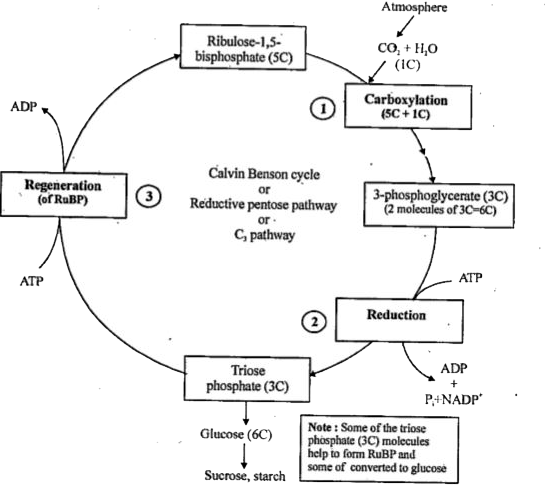Describe C3 pathway of carbon fixation. Does this pathway also operate in the C4 plants.
Text Solution
Calvin cycle is the arrangement of photosynthetic biosynthetic phase in which ribulose-5-phosphate is carboxylated, changed to three-carbon carbohydrate. It is also called the reductive pentose phosphate cycle or Photosynthetic carbon reduction (PCR) cycle. It takes place in the stroma of the chloroplast.
Stages of Calvin Cycle :
The three main stages into which the Calvin cycle is divided.
1. Carboxylation: In the first stage of the Calvin cycle, carbon dioxide combines with a five-carbon compound called RuBP (3-Ribulose bisphosphate), For three turns of the cycle, three CO2 molecules join with three RuBP molecules and form six three-carbon molecules 3-PGA (3 phosphoglyceride acid). The enzyme that catalyzes this reaction is RuBP carboxylase. It also exhibits oxygenase activity by accepting oxygen instead of carbon dioxide and is known as RuBP carboxylase-oxygenase (RuBisCO). It is located only in the chloroplasts.
RuBP+CO2RuBP carboxylase−−−−−−−−−−−−→Mg2+2−Carboxy−3−keto−1,5−biphosphoribotol+H2O→3PGA
Reduction: The resulting 3-PGA is reduced to glyceraldehyde -3- phosphate (G3P) which is a triose phosphate. It is a-two-step reaction in which 3-PGA is .first phosphorylated to 1,3-biphosphoglycerate and is then reduced to G3P. In this stage, both ATP and NADPH are required. Only one of these six GAP molecules is used in the manufacture of carbonhydrates. It is transported to cytoplasm but is first converted to dihydroxyacetone phosphate (DHAP). The other five molecules of G3P are recycled to resynthesize molecules of RuBP.
PGA+ATPPhosphoglycerine kinase−−−−−−−−−−−−−→1,3−Biphosphoglyceric acid+ADP
1,3−Biphosphoglyceric acid+NADPHG3P dehydrogenase−−−−−−−−−−−→G3P+P1+NADP+
Glyceraldehyde -3- phosphate (G3P) Phosphotriose isomerase−−−−−−−−−−−−−→ Dihydroxyacetone phosphate(DHAP)
Now, the two isomers G3P and DHAP condense to form fructose-1,6-biphosphate (FBP), which hydrolyzes to fructose -6- phosphate (F6P).
G3P+DHAPAldolase−−−−→FBP
FBP+H2OFructose-1,6-biphosphatase−−−−−−−−−−−−−−−→ Fructose-6-phosphate (F6P) + P1
Regeneration : A continuous supply of the acceptor molecule RuBP need to be maintained in order to maintain CO2 reduction. In this stage, the carbon atoms of the remaining five G3Ps are shuffled in a remarkable series of from RuBP with which the cycle began. The reactions involved are as follows:
Fructose -6- phosphate (F6P) + G3PTransketolase−−−−−−−→Erythrose -4- phosphate + Xylulose-5-phosphate
Erythrose-4-phosohate+Dihydtoxy acetone-3- phosphateAldolase−−−−→ Sedoheptulose-1,7-diphosphate
Sedoheptulose. 1,7-diphosphate+H2OSedoheptulose. 1,7-diphosphate−−−−−−−−−−−−−−−−−−→Sedoheptulose-1,7- phosphate+H3PO4
Sedoheptulose-1,7-diphosphate+G3PTransketolase−−−−−−−→Xylulose-5-phosphate + Ribose-5-phosphate (R5P)
Xylulose-5-phosphateRibulose-5-phosphate-3-epimeras−−−−−−−−−−−−−−−−−−−→Ribulose-5-phospliate (Ru5P)
Ru5P + ATPPhosphoribulokiitase−−−−−−−−−−−→RuBP + ADP
The reactions of Calvin cycle may be summed up as:
6CO2+18ATP+12NADPH+12H+Enzymes of−−−−−−−−→dark reaction6RuBP+C6H12O6+18ADP+12P+12NADP++6H2O

|
Similar Questions
Knowledge Check
Assertion: Plants possessing C4- pathway of carbon fixation have a higher net primary productively than the C3-pathway possessing plants.
Reason: For each unit weight of fixed carbon, C4-pathway possessing plants require less water than C3 pathway possessing plants.AIf both Assertion and Reason are true and the Reason is a correct explanation of the Assertion.BIf both Assertion and Reason are true but Reason is not a correct explanation of the Assertion.CIf Assertion and Reason are true but Reason is not a correct explanation of the Assertion.DIf Assertion is true but the Reason is false.C4 pathway of CO2 fixation was discovered by
ABlackmanBHatch and SlackCEmerson and ArnoldDArnon.Who described C4 pathway for the first time ?
AHatch and SlackBRobert hillCCalvinDWatson and Crick
Plants showing C4 pathway are better than the C3 plants in
View SolutionC4 pathway of CO2 fixation was discovered by
View SolutionDescribe carbon reactions of C3 pathway. Does this process operate in C4 plants.
View SolutionWho described C4 pathway for the first time ?
View SolutionThe first carbon fixation in C4 pathway occurs in chloroplasts of
View Solution
